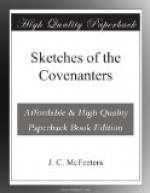This action was taken at a Conventicle held at Torwood early in the autumn of 1680. The attendance was large. The people knew not what was coming. Cargill was much animated. After a powerful sermon, he proceeded with the act of excommunication. The form was this:
“I, being a minister of Jesus Christ, and having authority from Him, do, in His name, and by His Spirit, excommunicate, cast out of the true Church, and deliver up to Satan, Charles II., upon these grounds: (1) His mocking of God; (2) His great perjury; (3) His rescinding all laws for establishing the Reformation; (4) His commanding armies to destroy the Lord’s people; (5) His being an enemy to true Protestants; (6) His granting remission and pardon to murderers; (7) His adulteries.”
Cargill knew that he would be adversely judged, by future generations, for what he had done; many would regard the excommunication as unreasonable and unwarrantable. He, therefore, adventured his reputation and authority on a prophecy, which he uttered in his sermon on the next Sabbath: “If these men die the ordinary death of men, then God hath not spoken by me.” King Charles was poisoned; the Duke of York died raving under the sentence; McKenzie died with blood flowing from many parts of his body; the Duke of Monmouth was executed; Dalziel died while drinking, without a moment of warning; Lauderdale sank into dotage through excessive indulgence; the Duke of Rothes passed into eternity in despair. The prophecy had its terrible fulfilment, to the last man. “It is a fearful thing to fall into the hands of the living God.”
Not much now remained for Cargill to do. A few more Conventicles, the acknowledgment of Christ’s supremacy before the judges, a public testimony on the scaffold; then the blood can flow, and seal the truth, which he loved so well to preach. His pursuers at length discovered him. Great was the rejoicing of his enemies when he was found, and bound, and hastened to prison. His trial was swift, issuing in the death sentence. His execution quickly followed. When he came to the gibbet, he placed his back against the ladder, and addressed the throng that had gathered to witness his last struggle. The venerable face beamed with happiness. That morning he had written some of his flowing thoughts. Here is one of them: “This is the most joyful day I ever saw; my joy is now begun never to be interrupted.” His soul was stirring with divine raptures; the glory of heaven was breaking around him. The thrill of youthful life again quickened his pulse; he wheeled about and mounted the scaffold, saying, “The Lord knows I go up this ladder with less fear and perturbation of mind than ever I entered the pulpit to preach.” Having reached the platform, where the rope was waiting for his neck, he bade adieu to earth, and welcome to heaven. “Farewell,” he exclaimed; “Farewell, all relations and friends in Christ; farewell acquaintances and all earthly enjoyments; farewell reading and preaching, praying and believing, wanderings and reproaches and sufferings. Welcome joy unspeakable and full of glory. Welcome Father, Son, and Holy Ghost! into Thy hands I commit my spirit.” What was death to a man like that but the beginning of glory! The black scaffold was lighted up with the radiance that streamed through the pearl gates.




